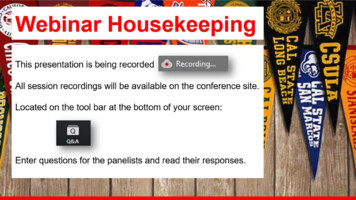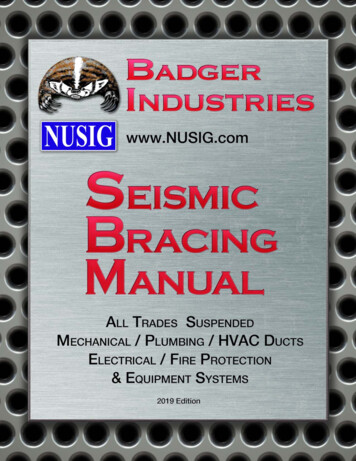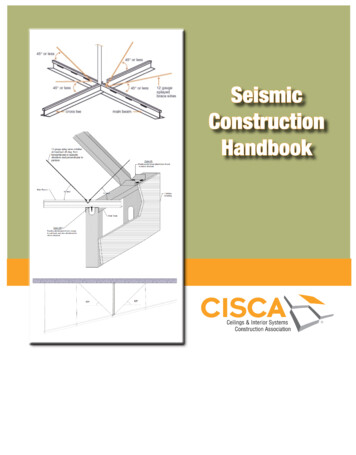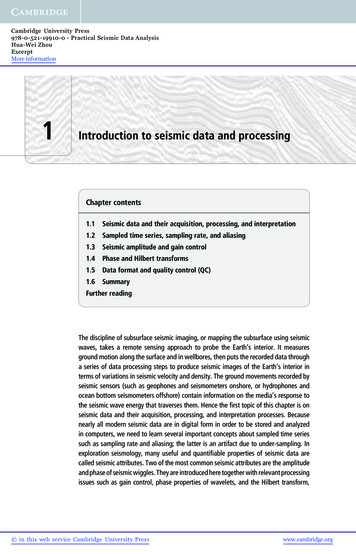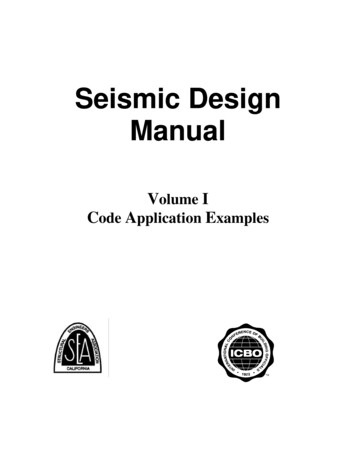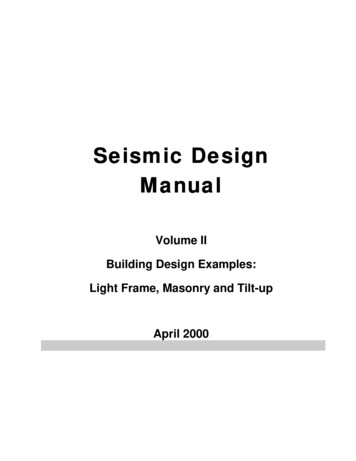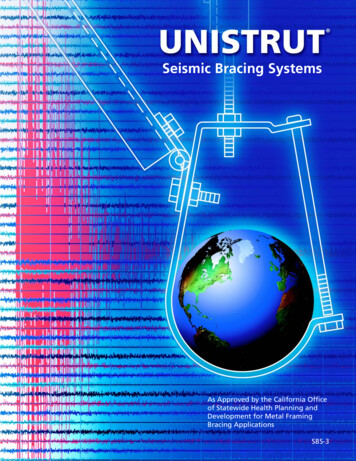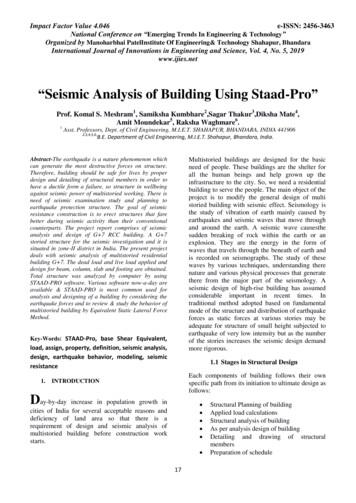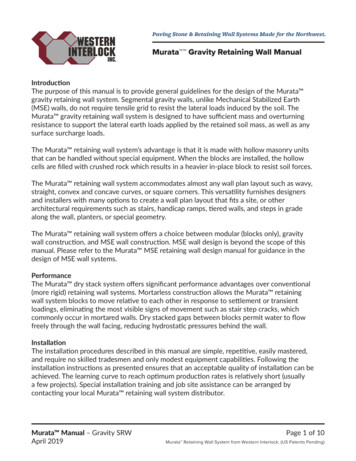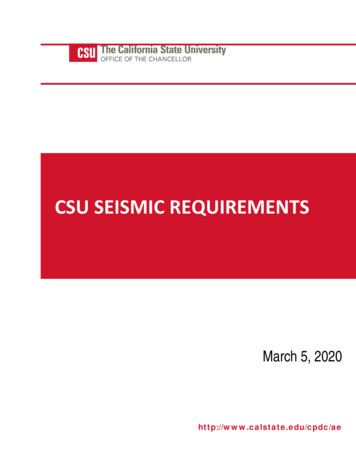
Transcription
CSU SEISMIC REQUIREMENTSMarch 5, 2020http://www.calstate.edu/cpdc/ae
CSU Seismic Policy Quick Start Guide*Read this if you don’t read anything else*Scope: These CSU Seismic Requirements were established to implement the Seismic Policy set by theBoard of Trustees. The CSU Seismic Policy applies to all structures within the bounds of a CSU campusmaster plan. If a campus seeks to conduct operations at an off-campus location, the facility must beevaluated according to the ‘Standards for Acquiring Buildings and Space’ (Lease/Acquisition Policy).Project funding source has no effect on peer review need. CSU use is the determining factor. (Sec. 3.2,3.4, 8.0)Planning for all Capital Projects: Planning for all projects shall address the options considered to improveseismic performance beyond minimally required code conformance. The basis for determination of theselected option selected for shall be documented. (Sec. 7.0)What Needs Seismic Peer Review: All major capital building projects require peer review. All minorcapital building projects shall be seismically assessed; however, a Campus Deputy Building Official mayissue a written waiver for individual minor capital infrastructure and capital projects that do not havematerial seismic issues. In doubt, contact the campus peer reviewer to assess a project’s peer reviewneed. (Sec. 3.7, 4.0, 5.5)Early Notice to Design Team of Seismic Design Coefficients and Risk Category: The CSU hasestablished campus-specific ‘seismic ground motion parameters’ that supersede California Building(CBC) values and implements a conservative evaluation on CBC Structural Risk Category assignments. Asthese can have a substantial effect on project costs, it is imperative that campuses inform Contractorand Design team proposer of these CSU seismic requirements at the solicitation stage of a project. (Sec.3.1, 3.3)Peer Review: Peer review starts at project inception and continues until construction completion. Peerreview concurrence letters are issued at completion of the Schematic Preliminary Design andConstruction Documents Phases, and during the course of construction on deferred submittals that havea seismic component. (Sec. 4.0) All SRB peer review comments is required before start of construction,resolution of SRB construction phase submittals must be required prior to occupancy. (Sec. 3.8, 4.4, 5.18)When Required: Engage peer review concurrent with Project RFP development. Secure peer reviewconcurrence letters in advance of advertisement for proposals, CPDC schematic presentation and beforeconstruction begins. (Sec. 3.8, 4.2)Purchase, Lease: The CSU Seismic Requirements have standards for the purchase, lease, license andother form of acquisition or occupancy of buildings, or portions thereof. Compliance is required beforeactual occupancy begins. (Sec. 1.0, 8.0)Special Conditions: The CSU Seismic Requirements address many special conditions including:Geotechnical Investigations, Modular Buildings, Pre-engineered Structures, Temporary Use of Buildings,Voluntary Retrofits, Use of Engineered Wood Products, and Designated Seismic Systems. (Sec. 5.0)Change of Use: Temporary use changes ( 7 days) require a Special Event Permit. Coordinate with CDBO.Renovations that alter an existing CBC Use and Occupancy require CDBO and SRB review. Early conceptreview by SRB can readily provide an informal advisory assessment. (Sec. 5.20)CSU Seismic Priority Lists: Buildings on the CSU Priority Lists require seismic improvements be includedas a part of the project scope of any renovation work. (Sec. 7.0)CSU Seismic Emergency Response: In the event of a seismic or structural emergency contact any SRBpeer reviewer to assess the need for a mobilization response. If a mobilization response is warrantedCampus Deputy Building Official functions will be temporarily assumed by the SRB to rapidly assess whichbuildings are safe for use. (Sec. 6.0)Responsibility of Design Professionals During Construction: Design professionals are expected todirectly notify the CSU construction manager and seismic peer reviewer of potential constructionchanges or modification to the approved design documents that can substantively impact expectedstructural performance, and where appropriate directly contact the Seismic Peer Reviewer forconsideration of and concurrence with the changes as specific conditions warrant. (Sec. 3.10)i
Table of Contents1. CSU SEISMIC POLICY . 12. SEISMIC REVIEW BOARD . 23. CODES AND STANDARDS APPLICABLE TO CSU CONSTRUCTION ACTIVITY . 23.1 Minimum Requirements. 33.2 Application to New Buildings . 43.3 Campus Seismic Coefficients. 43.4 Application to Existing Buildings . 63.5 Code Enforcement . 73.6 Active Faults . 83.7 Peer Review for Small Projects . 93.8 Peer Review Verification . 103.9 Engineer-of-Records (EOR) . 103.10 Responsibility of Design Professionals during Construction . 103.11 Special Inspections . .114. PEER REVIEW . 114.1 Scope of Review . 124.2 Timing of Peer Review . 134.3 Reports . 134.4 Responses and Corrective Actions . 134.5 Distribution of Reports. 144.6 Design Professional Responsibilities . 144.7 Resolution of Differences. 144.8 Peer Review Contracts and Cost . 145. SPECIAL CONSIDERATION. 145.1 Private Building Constructed on CSU Land . 145.2 Geotechnical Investigations . 145.3 EOR References to Geotechnical Investigations . 155.4 Changes and Additions to Published SRB Requirements . 155.5 Projects Not Warranting Peer Review . 155.6 Demolition Projects. 165.7 Material Properties of Existing Building. 165.8 Design Build and CM at Risk Projects . 165.9 Special Moment Frame Structural Systems . 175.10 Post-tensioned Structural Elements . 175.11 Alternative Methods of Construction . 175.12 Use of Engineered Wood Products . 185.13 Deferred Approvals or Multiple Design Packages . 185.14 Pre-engineered Structure . 195.15 Designated Seismic Systems . 205.16 Parking Structure Risk Category Determination . 215.17 Phased and Voluntary Retrofit . 215.18 Final Approval . 215.19 Earthquake Soil Pressure . 215.20 Temporary Use of Building and Structures . 226. POST EARTHQUAKE REVIEWS . 23ii
7. PROJECT PLANNING . 247.1 Priority Lists . 247.2 Project Planning 258. SEISMIC SAFETY STANDARD FOR ACQUIRING BUILDING AND SPACE . 258.1 Types of Acquisitions . 26A. Acquire By Lease or License . 26B. Acquire By Purchase or Title Transfer . 268.2 Acceptable Evaluation Document . 27A. Waiver Letter . 27B. FEMA Evaluation Report. 27C. Certification of Applicable Code . 28D. Independent Review report . 28Attachment A . 30CALIFORNIA STATE UNIVERSITY SEISMIC REVIEW BOARD. 30Attachment BSeismic Coefficients for CSU Campus Locations . 31Table 1CSU Campus Seismic Ground Horizontal Response Spectra Parameters . 32Table 1 Notes . 40Attachment CCampus Assignments for Peer Review . 41Attachment DEarthquake Performance Levels for Existing Buildings . 42Attachment ETechnical Guidelines . 44Attachment FReferences. 47Attachment GDocument History . 48iii
CSU Seismic RequirementsOriginally Adopted December 8, 2000; revised March 5, 20201. CSU SEISMIC POLICYThe California State University (CSU) Board of Trustees adopted the following policy to apply toall CSU construction projects.RESOLVED, by the Trustees of the California State University, that thefollowing policy is adopted:It is the policy of the Trustees of the California State University that to themaximum extent feasible by present earthquake engineering practice toacquire, build, maintain, and rehabilitate buildings and other facilities thatprovide an acceptable level of earthquake safety for students, employees,and the public who occupy these buildings and other facilities at alllocations where University operations and activities occur. The standardfor new construction is that it meets the life safety and damageabilityobjectives of Title 24 provisions; the standard for existing construction isthat it provides reasonable life safety protection, consistent with that fortypical new buildings. The California State University shall cause to beperformed independent technical peer reviews of the seismic aspects of allconstruction projects from their design initiation, including both newconstruction and remodeling, for conformance to good seismic resistantpractices consistent with this policy. The feasibility of all constructionprojects shall include seismic safety implications and shall be determinedby weighing the practicality and cost of protective measures against theseverity and probability of injury resulting from seismic occurrences.[Approved by the Trustees of California State University at its May 18-19, 1993 meeting(RTCPBG 05-93-13).]This policy is the basis for CSU seismic actions. CSU undertook the assessment of the seismichazard posed by the University’s building stock at the direction of Governor Deukmejian in 1992with resources provided by the Legislature in 1993. Since then CSU has had a vigorous programof reducing the unacceptable seismic risk to acceptable levels.The CSU Seismic Requirements describe the CSU framework used to implement the Trustees’Seismic Policy. Key objectives and requirements are excerpted below. Additional backgroundinformation and direction to the related policy requirements are provided for each.1. To the maximum extent feasible by present earthquake engineeringpractice the goal is to acquire, build, maintain, and rehabilitate buildingsand other facilities that provide an acceptable level of earthquake safety.Discussion: Actions necessary to accomplish this goal were initiated in1992 for existing buildings and will continue until all CSU existingbuildings meet the seismic safety objective of the Trustees and all newconstruction meets this goal. Each year capital expenditures arerecommended until the unacceptable safety hazard buildings areseismically retrofitted or removed from service. The Seismic ReviewBoard (SRB) is responsible to the Chancellor for review of expectedCSU Seismic RequirementsMarch 5, 2020Page 1
seismic performance characteristics of all CSU buildings and advises theChancellor of actions necessary to achieve an acceptable level of seismicrisk for CSU buildings. The SRB is addressed in Section 2. Safe use ofbuildings subjected to possible earthquake damaged is addressed inSection 6. Other special issues are addressed in Section 5. Standards forthe acquisition and lease of buildings are given in Section 8.2. The standard for: New construction is that it meets the life safety and damageabilityobjectives of Title 24 provisions: Renovation construction is that it provides reasonable life safetyprotection, consistent with that for typical new buildings.Discussion: The California Building Code (CBC) provides constructionstandards for both new construction and renovation of existing buildings.The code has added provisions for existing buildings since the Trustees’policy was established. (The implementation of these standards isaddressed in Section 3)3. Independent technical peer reviews shall be conducted concerning theseismic aspects of all construction projects from their design initiation,including both new construction and remodeling, for conformance togood seismic resistant practice consistent with this policy.Discussion: The SRB is delegated responsibility to conduct independentpeer reviews of all CSU construction projects. Conduct of seismic peerreviews is addressed in Section 4.4. The feasibility of all construction projects shall include seismic safetyimplications and shall be determined by weighing practicality and cost ofprotective measures against the severity and probability of injuryresulting from seismic occurrences.Discussion: The CBC establishes minimum standards for building safety.Section 7 of the CSU Seismic Requirements addresses the incorporationof seismic design and review into facilities planning and campusdevelopment.2. SEISMIC REVIEW BOARDThe SRB was established in 1992. It is charged with implementing the independent peer reviewrequirements of the Trustees’ seismic policy. The Board also advises CSU on structural engineeringissues for specific projects. Membership is comprised of professionals not otherwise affiliatedwith the University system. Board members are appointed by, and serve at the discretion ofthe Chancellor. The Board membership is listed in Attachment A.3. CODES AND STANDARDS APPLICABLE TO CSU CONSTRUCTION ACTIVITYBy law, the California State University is required to enforce the current edition of the CBCas adopted by the California Building Standards Commission. To facilitate this legal requirementthe CSU has adopted, as policy, selected additional sections of Chapter 1 Scope andAdministration of the CBC related to code administration, code enforcement, and codeinterpretation. See State University Administrative Manual (SUAM) Section XI for listing ofCSU Seismic RequirementsMarch 5, 2020Page 2
sections adopted as policy. This Seismic Policy supplements the requirements of the CBC. Whererequirements differ the more restrictive shall apply.The Building Code applies to all construction activity undertaken by CSU and applies to bothseismic and non-seismic requirements for construction. The two sections address the seismicdesign of structures: the requirements for new buildings are found in Chapter 16 of Part 2volume 2 of the California Code of Regulations, known as the California Building Code (CBC); andthe requirements for existing retrofit/renovation and repair to campus buildings are found Part10 of the California Code of Regulations, Part 10, termed the California Existing Building Code(CEBC).The CSU Building Official is responsible for enforcement of this code. A Deputy Building Official(CDBO) is designated on each campus and has the delegated responsibility under the directionof the Building Official to enforce the code at the associated campus and those additional sitesunder campus jurisdiction.Designated historic structures may be subject to the State Historic Building Code; theserequirements are in addition to the same life safety objectives as provided in CBC and CEBC.3.1Minimum RequirementsThe current edition of the CBC provides the minimum requirements for the regulationof all California State University construction activity. It applies to all construction,whether it is new, or an addition, modification or alteration of an existing structure.The seismic requirements of CEBC for existing buildings are less stringent than CBC part2, Chapter 16 for new buildings. The intent of CEBC is retrofit and repair of existingstructures that will yield an essential life safety level of performance. Essential lifesafety seeks to provide design performance that will allow occupants in a seismicevent to exit the structure safely. CBC Part 2, Chapter 16 may be used for modificationsof an IEBEC existing building if so desired.The required seismic provisions can be modified by the campus to provide a higherlevel of seismic performance, but may not be modified to provide a lower level ofseismic performance. Chapter A1 allows the Building Official to enforce otherprovisions as long as they do not diminish the safety of the facility. At any time where theresponsible CSU Building Official chooses to exercise the authority of Section 104.10Modifications, the basis for the modification must be reviewed and approved by theSRB prior to approval of the plans for construction.Consistent with CEBC, the retrofit or repair of a structure to essential life safety as alevel of expected structural performance intends that occupants will be able to exit thestructure safely following an earthquake. It does not necessarily mean that theoccupants will be uninjured or not need medical attention. A structure is presumed toachieve this level of performance where: although significant damage to the structuremay have occurred, some margin against total and significant partial structural collapseremains, even though damage may not be economical to repair; major structuralelements have not become dislodged or fallen so as to pose a life- safety threat; and,nonstructural systems or elements, which are heavy enough to cause severe injurieseither within or outside the building, have not become dislodged so as to pose a lifesafety threat. Window glass, roofing tile and elements of non- structural claddingsystems are not generally considered to be a falling hazard to be included within thiscategory of concern, except over primary entrance.CSU Seismic RequirementsMarch 5, 2020Page 3
Special Note: CBC Section 1604.5 requires the [Structural] Risk Category be determinedfor every building. Table 1604.5 characterizes the nature of the Risk Category for variousoccupancies and uses. Occupancy load is typically calculated per Table 1004.1.2. Oncethe occupancy load is determined, Table 1604.5 is applied to assign the Risk Categoryfor structural design purposes. These requirements broadly apply to all CSU buildings,including non-classroom buildings and non-state funded buildings such as dormitories,dining centers, student unions, student recreation centers, student health centers, officebuildings, stadia, aquatic facilities etc. Among the designations of Table 1604.5 is Buildings and other structures containing adult education facilities, suchas colleges and universities, with occupancy load greater than 500.When a building exceeds this triggering threshold, it shall be classified as Category III use,unless other designations trigger a more restrictive designation. Note that the occupancydetermined by the design team (architect) is based on fire rated occupancies andconfirmed by the Building Official.Certain CSU operations including: emergency operations centers, public safety buildings,water storage facilities and pump structures required to maintain water pressure for firesuppression trigger a Category IV use classification.Exception: Parking Structures: The occupancy threshold trigger for Category III inclusionof parking structures is 5,000 occupants as calculated by CBC Table 1004.1.2. Requiring aCategory III inclusion at 500 occupants for the inherently short-term, transient occupancyof a parking structure use is inconsistent with the CBC intent to provide supplemental,concentrated occupancy protection otherwise broadly afforded to college and universityadult education facilities.3.2Application to New BuildingsThe policy requirements apply to all construction whether new o r modification of anexisting building. Additions to an existing building that are seismically separated fromthat existing building shall meet the requirements for a new building. An addition maybe considered seismically separated if the response of its structural elements will not bedirectly impacted by those of the existing building, either because they are not physicallyconnected or the physical separation is sufficient to avoid contact during an earthquakeresponse. The addition’s foundation systems may be in contact if they are at or belowgrade and both existing and new foundations have been evaluated to avoid surchargingthe other.3.3Campus Seismic CoefficientsCBC Part 2, Chapter 16 and C E B C Part 10 require seismic coefficients for structuralcalculations. CSU has adopted specific seismic parameters (Attachment B) to be used atall sites within the contiguous portions of a given campus that supersede those providedin the CBC.For new buildings, the Risk-Targeted Maximum Considered Earthquake (MCER) GroundMotion Response Acceleration parameters (SMS and SM1) and the Design Earthquake (DE)Ground Motion Response Acceleration parameters (SDS and SD1) shall not be less than therespective BSE-2N (MCER) and BSE-1N (DE) values given in Table 1 of Attachment B for theSite Class corresponding to the site-specific subsurface conditions of the building location.Corresponding Peak Ground Acceleration parameter values (PGAM and PGAD) to be usedfor evaluation of potential geologic/seismic hazards are also given in Table 1 of AttachmentCSU Seismic RequirementsMarch 5, 2020Page 4
B.Similarly, the ground motion response acceleration parameters used for evaluation and/orretrofit of existing buildings shall not be less than the respective BSE-C (SCS and SC1) andBSE-R (SRS and SR1) values given in Table 1 of Attachment B for the Site Class correspondingto the site-specific subsurface conditions of the building location. As specified in the CBC,the BSE-C and BSE-R parameters are associated directly to hazard levels of 5% and 20%probabilities of exceedance (PE) in 50 years, respectively, and are not constrained by BSE2N (MCER) and BSE-1N (DE) values. Corresponding Peak Ground Acceleration parametervalues (PGAC and PGAR) to be used for evaluation of potential geologic/seismic hazards atthe respective hazard level are also given in Table 1 of Attachment B.The campus seismic ground motion parameters given in Table 1 of Attachment Bcorrespond to reference rock Site Class BC (VS30 760 m/s) as utilized by the U.S.Geological Survey (USGS) in developing the U.S. Seismic Design Maps, as well as SiteClasses C and D, with adjustments made using site coefficients Fa, and Fv per ASCE/SEI 716 Tables 11.4-1 and 11.4-2, respectively, and FPGA, per ASCE/SEI 7-16 Table 11.8-1.The site-specific subsurface conditions are to be determined for the building/facility siteby the geotechnical engineer as part of the project’s development. Site Class at a givenbuilding/facility site location shall be determined based on site-specific soil and/or rockproperties data in accordance with the Site Class definitions given in ASCE/SEI 7 Chapter20. If soil and/or rock properties information is not available in adequate detail todesignate the Site Class per ASCE/SEI 7 Chapter 20, the Default D Site Class shall be used,unless geologic/geotechnical information indicates that Site Class E or F ground conditionsmay be present at the site that could trigger the need for site-specific hazard analyses.For locations not covered in Attachment B, the CSU Seismic Review Board shall providesuch values for design.Use of the seismic ground motion parameters given in Table 1 of Attachment B supersedesthe provisions of ASCE/SEI 7 Chapter 11, Section 11.4.8, requiring site-specific groundmotion hazard and/or site response analyses for structure locations at CSU campuses withSite Class D ground conditions. Site-specific ground motion hazard and/or site responseanalyses may still be required for Site Classes E and F ground conditions. Site-specificground motion hazard and/or site response analyses are permitted for any Site Class, ifwarranted by the nature or special characteristics of a project; however, the need for suchsite-specific analyses, as well as the methodology for these analyses and analysis results,shall be subject to peer review by the geotechnical member of the CSU Seismic ReviewBoard.The 2016 Edition of the CBC changed the basis of design for many CSU campuses and thatchange is carried forward to the current version of the CBC. The CBC references ASCE/SEI7 for the requirements of new buildings. ASCE/SEI 7 Section 11.6 requires that wheneverthe mapped spectral response acceleration parameter value at a 1-second period, i.e.,BSE-2N (MCER) SM1 for Site Class BC, is equal to or greater than 0.75, then buildings in RiskCategories I, II, and III shall be assigned to Seismic Design Category E and buildings inRisk Category IV shall be assigned to Seismic Design Category F. For all Categories ofbuil
of seismic design and review into facilities planning and campus development. 2. SEISMIC REVIEW BOARD The SRB was established in 1992. It is charged with implementing the independent peer review requirements of the Trustees’ seismic pol
